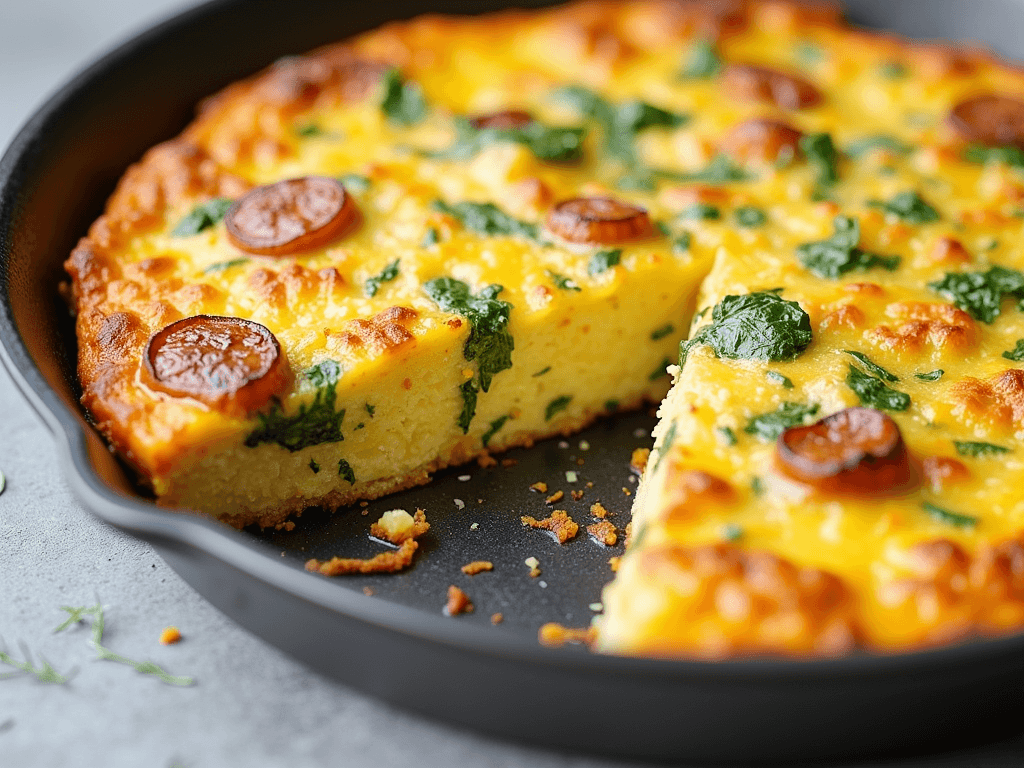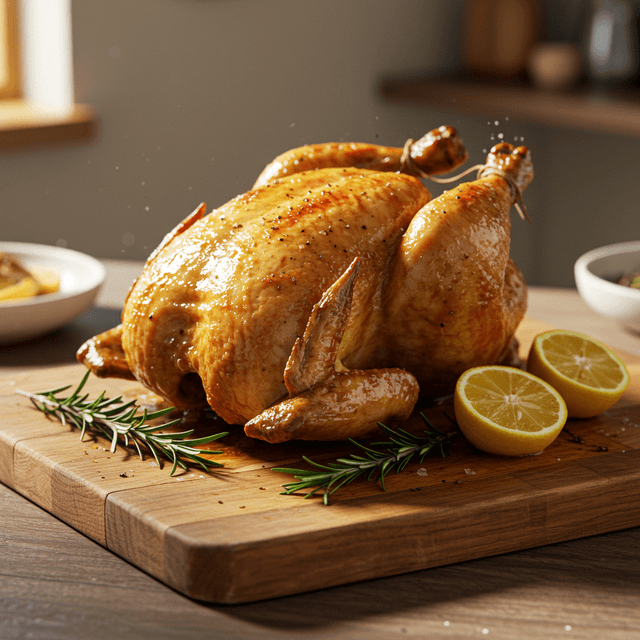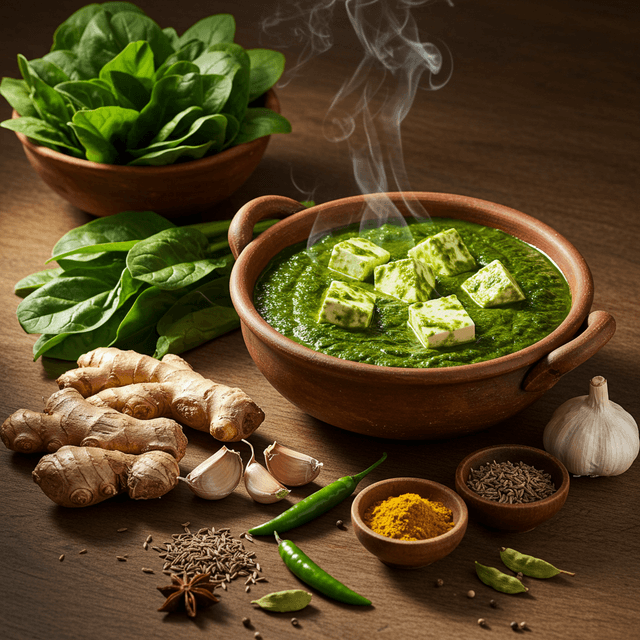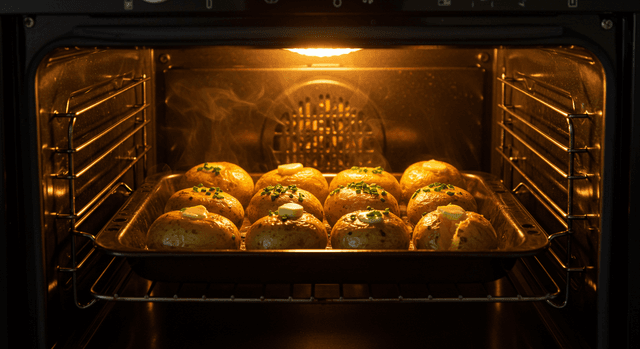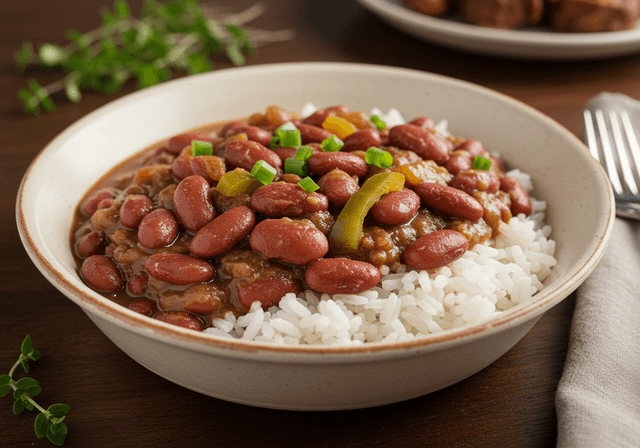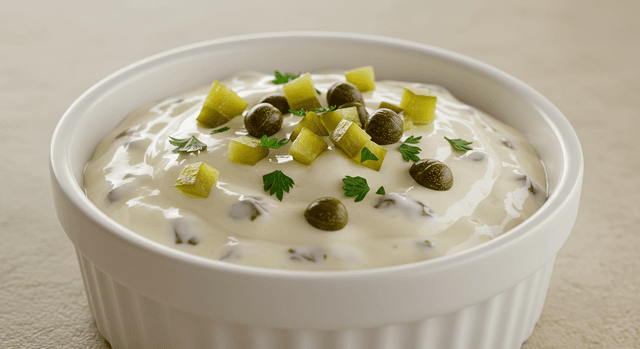Best Techniques for a Fluffy and Juicy Frittata
Perfect Ingredient Proportions
The key to a perfect frittata lies in the proportions. For every 6 eggs, use ¼ cup of heavy cream, which will result in a tender and creamy texture.
Beating Techniques
To achieve a fluffy frittata, it's essential to beat the eggs correctly:
- Use an immersion blender or regular mixer to incorporate air into the eggs. This will help achieve a lighter texture.
- Beat only until the yolks and whites are combined, without overdoing it. Excessive beating can result in a dense texture.
- If beating by hand, do it vigorously to create air bubbles. This will ensure a fluffy and uniform texture.
Key Ingredients for Creaminess
- Use high-fat dairy products for better texture. This will guarantee a richer and smoother frittata.
- Heavy cream is the best option, though you can substitute with yogurt, milk, or crème fraîche. Each alternative will bring its own flavor and texture.
- You can add up to ½ cup of cream per dozen eggs. This proportion ensures the perfect balance between creaminess and firmness.
Temperature and Cooking Control
- Preheat the oven to 400°F (200°C). This temperature allows for even cooking and proper browning.
- Don't overcook - overcooked eggs become rubbery. It's better to remove the frittata when it's still slightly moist in the center.
- Check the frittata after 15 minutes of baking. This is the critical point to determine the cooking point.
- The frittata is ready before the top browns completely. A slight jiggle in the center indicates the perfect point.
Pan Preparation
- Use a hot, well-greased pan to prevent sticking. This will facilitate unmolding and ensure a golden bottom.
- Preferably use a cast iron or oven-safe non-stick pan. These pans distribute heat better and are more durable.
- If using a stainless steel pan, add more oil or butter. This will compensate for the material's lower non-stick capacity.

Techniques for Beating Eggs for a Frittata
To achieve a fluffy and juicy frittata, beating the eggs is a crucial step that must be done with care. Here are the specific techniques for properly beating the eggs:
Importance of Beating
Properly beating the eggs not only helps mix the ingredients but also incorporates air, resulting in a lighter and fluffier texture in the frittata. A good beating is essential to prevent the frittata from becoming dense or rubbery.
Recommended Tools
- Immersion blender or electric mixer: These tools are ideal for efficiently incorporating air. Use medium speed to avoid overheating the eggs.
- Manual whisk: If you choose to beat by hand, a whisk is the best option. This will allow you to have better control over the mixture.
Beating Process
- Incorporating air: When using a blender or mixer, beat until the yolks and whites are fully combined and a light foam forms. This can take about 1 to 2 minutes.
- Avoid overbeating: It’s important not to overbeat. An excessive mixture can break the air bubbles and result in a dense texture. Stop as soon as you see that the mixture is homogeneous.
- Manual beating: If you decide to beat by hand, do so with quick, vigorous circular motions. This will help create air bubbles without breaking down the egg structure.
Incorporating Ingredients
- Adding other ingredients: If you plan to add ingredients like cheese or vegetables, do so after beating the eggs. Mix gently to avoid deflating the air bubbles you’ve created.
- Resting: Let the mixture rest for a few minutes before cooking. This allows the air to settle and helps maintain fluffiness during cooking.
Additional Tips
- Controlling salt: Avoid adding salt at the beginning of the process, as it can break down the egg proteins and affect texture. Add salt just before cooking or at the end.
These techniques will ensure that your frittata has a light and fluffy texture, contributing to its success at any meal.

Specific Vegetable Cutting Techniques for Frittata
The proper cutting of vegetables is essential to ensure they cook evenly and contribute to the texture and flavor of the frittata. Here are the specific techniques for cutting the most common vegetables used in this dish.
Importance of Cutting
A good cut not only enhances the presentation of the dish but also ensures even cooking. Vegetables should be cut into sizes that allow for proper cooking without falling apart or remaining raw.
Recommended Cutting Techniques
- Julienne: This cut consists of thin strips approximately 1 mm thick and 5 to 6 cm long. It is ideal for vegetables like carrots, zucchini, and bell peppers, as it allows them to cook quickly and mix well with the eggs.
- Brunoise: This method involves cutting into small cubes, typically around 1 mm. It is perfect for onions and bell peppers, as they integrate well into the mixture without overpowering the flavor.
- Emincé: This cut involves slicing vegetables into thin rounds. It is ideal for onions and leeks, as they cook quickly and add a sweet flavor to the dish.
- Chiffonade: Primarily used for leafy greens like spinach or Swiss chard. This technique involves stacking the leaves, rolling them up, and slicing them into thin strips. This helps them cook quickly and distribute evenly in the frittata.
- Cubed Cut: For larger vegetables like potatoes or zucchini, a cubed cut (approximately 1 cm) is recommended. This ensures they cook properly without falling apart.
Cutting Tips
- Uniformity: Aim to maintain a uniform size in all cuts to ensure even cooking. Smaller pieces will cook faster, while larger ones may remain raw.
- Use sharp knives: A sharp knife makes cutting easier and reduces the risk of accidents in the kitchen.
- Preparation beforehand: Wash and dry the vegetables thoroughly before cutting them. This is not only a matter of hygiene but also helps prevent the vegetables from becoming watery during cooking.
Examples of Common Vegetables
- Onion: Cut into julienne or emincé for a mild flavor.
- Bell Pepper: Cut into cubes or thin strips to add color and texture.
- Zucchini: Can be sliced or julienned, depending on your desired style.
- Spinach: Use the chiffonade technique for easy integration.
By applying these cutting techniques, you will not only improve the presentation of your frittata but also enhance its flavor and texture, ensuring a delicious and well-balanced dish.

Ingredients
To prepare a delicious frittata, it is important to have the right ingredients. Below are the necessary ingredients along with their quantities and functions in the recipe.
- Eggs : 6 units. They provide the base and structure of the frittata, offering protein and texture.
- Heavy cream : ¼ cup. It adds creaminess and smoothness to the mixture, making the frittata richer.
- Onion : 1 medium unit, chopped. It adds flavor and sweetness, as well as a touch of texture.
- Bell pepper : 1 unit (red or green), chopped. It adds color and a fresh flavor to the frittata.
- Spinach : 1 cup, fresh or cooked. It provides nutrients and an earthy flavor, along with a nice green color.
- Cheese (optional) : ½ cup, grated (can be feta, mozzarella, or cheddar). It adds flavor and a creamy texture when melted.
- Salt : to taste. It enhances all the flavors of the ingredients.
- Black pepper : to taste. It adds a touch of spice and depth to the flavor.
- Olive oil : 1 tablespoon (for greasing the pan). It helps prevent the frittata from sticking and adds extra flavor.
- Spices (optional) : to taste (such as oregano or basil). They can add an additional flavor profile based on personal preferences.
These ingredients are essential for achieving a delicious and well-balanced frittata in terms of flavor and texture.

How to Prepare a Frittata Step by Step
Preparing a frittata is a simple and rewarding process that allows you to enjoy a delicious and nutritious dish. Below are the detailed steps to make a perfect frittata, interconnecting the necessary ingredients at each stage.
Step 1: Prepare the Ingredients
- Chop the vegetables: Start by chopping the onion (1 unit) into small pieces and cutting the bell pepper (1 unit) into julienne strips. Use proper cutting techniques to ensure they cook evenly.
- Wash and prepare the spinach: If using spinach (1 cup), make sure to wash it well and, if it's fresh, cut it into large pieces. This will help it integrate better into the mixture.
Step 2: Beat the Eggs
- Beat the eggs: In a large bowl, crack 6 eggs and beat them with a manual whisk or blender. Make sure to incorporate air to achieve a fluffy texture, as mentioned in the beating techniques.
- Add heavy cream: Add ¼ cup of heavy cream to the beaten eggs. This will provide creaminess and smoothness to the frittata.
Step 3: Cook the Vegetables
- Heat the pan: In a hot skillet, add 1 tablespoon of olive oil for greasing. This will prevent the frittata from sticking and help brown the ingredients.
- Sauté the onions and bell peppers: Add the chopped onion and bell pepper to the skillet. Sauté over medium heat until they are tender, about 5 minutes.
Step 4: Incorporate Spinach and Other Ingredients
- Add spinach: Incorporate the spinach into the onion and bell pepper mixture. Cook until the spinach wilts, which will take about 2 minutes.
- Mix with eggs: Pour the beaten egg mixture over the vegetables in the skillet. Add salt and pepper to taste to enhance the flavors. You can also add spices like oregano or basil for an additional flavor profile.
Step 5: Cook the Frittata
- Initial cooking on the stove: Cook over medium-low heat for about 5 minutes, gently moving with a spatula to prevent sticking. This will help lightly brown the bottom.
- Flip the frittata: To flip the frittata without breaking it, use a large plate. Place the plate over the skillet and quickly flip it over, then slide the frittata back into the skillet to cook the other side.
- Bake to finish cooking: Preheat the oven to 400°F (200°C) and then place the skillet in the oven. Bake for 10-15 minutes or until the center is fully cooked and firm.
Step 6: Serve
- Remove from oven: Once cooked, remove the frittata from the oven and let it rest for a few minutes before slicing. This will make cutting easier and help maintain its shape.
- Optionally, add cheese: If you decide to use cheese (½ cup), sprinkle it over the frittata just before baking so that it melts perfectly.
By following these steps, you will enjoy a delicious frittata that is well-balanced in flavor and texture. Remember to apply the techniques discussed earlier to ensure your frittata is fluffy and juicy. Enjoy!

Tricks for Flipping the Frittata Without Breaking It
Flipping a frittata can be a challenge, but with the right tricks, you can do it without breaking it. Here are some practical tips to achieve success.
Use a Non-Stick Pan
- Make sure to use a good quality non-stick pan. This will prevent the frittata from sticking and facilitate sliding when flipping.
- If possible, reserve a pan specifically for making frittatas. This will help keep the surface in optimal condition.
Wait Until It Is Well-Cooked
- Before attempting to flip the frittata, ensure that the edges and bottom are well-cooked. This will give it structure and prevent it from crumbling.
- If the top is still a bit liquid, you can cover it with a lid for a few minutes to help it set without needing to flip.
Use a Large Plate
- Place a large plate over the skillet and make sure it is larger than the surface of the pan. This will give you space to maneuver when flipping.
- Carefully tilt the skillet toward the plate and make a quick motion to flip the frittata. Be sure to keep the plate and skillet aligned to avoid spills.
Alternative Method: Tilt and Slide
- If you are working with a larger frittata, tilt the skillet over the plate instead of flipping it completely. Let the frittata slide gently onto the plate.
- Then, turn the empty skillet upside down over the plate, and invert the plate back onto the skillet, sliding the frittata back into the skillet to finish cooking.
Use Oil on the Plate
- Spread a little oil on the plate before placing the frittata on it. This will help it slide easily when putting it back in the skillet.
- Make sure that the edges of the frittata are well-cooked before attempting to flip it. This will minimize the risk of breaking.
Practice and Be Patient
- Like any culinary technique, flipping a frittata may require some practice. Don’t be discouraged if it doesn’t come out perfect on your first try.
- Over time, you will build confidence and skill in this process, making it easier each time.
By following these tricks, you will successfully flip your frittata and enjoy a deliciously presented dish. Good luck!

The Perfect Pairing: Which Wines Go Best with Frittata
The frittata is a versatile dish that pairs well with a variety of wines, making it an ideal choice for enjoying at brunch or informal meals. Here are some pairing recommendations that enhance the flavors of the frittata.
Sauvignon Blanc
- This white wine is a classic option to accompany the frittata. Its high acidity and herbal notes perfectly complement the flavors of the vegetables and eggs.
- A Sauvignon Blanc from New Zealand or California can highlight fresh ingredients like spinach and bell peppers, creating an ideal balance.
Prosecco
- Prosecco, with its light and bubbly character, is another excellent choice. Its fruity notes, such as peach and apple, pair well with the creaminess of the frittata.
- The bubbles in Prosecco help cleanse the palate between bites, making each portion of frittata even more refreshing.
Fiano
- This Italian wine is ideal for richer frittatas that contain ingredients like cheese or ham. Its layers of stone fruit and melon add depth to the dish.
- The "waxy" texture of Fiano complements the creaminess of the eggs, creating a harmonious tasting experience.
Champagne
- A good Champagne can elevate any meal, including frittata. Its refreshing acidity and citrus notes enhance the lightness of the dish.
- Additionally, the bubbles in Champagne add a pleasant texture that pairs well with the softness of the ingredients.
When choosing a wine to pair with your frittata, consider the types of ingredients you have used and look for a wine that complements their flavors without overwhelming them. With these pairing options, you can enjoy a complete and satisfying dining experience. Cheers!

Tips for Storing and Reheating a Frittata
Storing and reheating a frittata properly is essential to maintain its flavor and texture. Here are some practical tips to do it effectively.
Storing the Frittata
- Let it cool before storing: Allow the frittata to cool at room temperature for 15-30 minutes. This prevents moisture buildup in the container.
- Use an airtight container: Store the frittata in a glass or plastic airtight container in the refrigerator at 40°F (4°C) or lower. This helps maintain its freshness and avoid odors.
- Refrigerator duration: The frittata can last in the refrigerator for up to 3-4 days. Be sure to check it for any signs of spoilage before consuming.
Reheating the Frittata
- In the skillet: Place the frittata in a non-stick skillet over medium-low heat. Add a little olive oil and cover with a lid. This can take between 5 and 10 minutes.
- In the oven: Preheat the oven to 350°F (175°C) and place the frittata in an oven-safe dish. Cover it with aluminum foil and bake for 10-15 minutes.
- In the microwave: Cut the frittata into portions and place them on a microwave-safe plate. Cover with a damp paper towel and heat in 30-second intervals until hot.
Additional Tips
- Avoid excessive reheating: Do not reheat the frittata more than once, as this can increase the risk of bacteria. Always ensure it is heated thoroughly before serving.
- Freezing: If you want to store it longer, you can freeze the frittata. Cut it into portions and wrap them individually in plastic wrap. Place the portions in an airtight container or freezer bag; it can last up to 3 months frozen.
By following these tips, you can enjoy your frittata at its best, whether freshly made or reheated. Enjoy!

Frequently Asked Questions (FAQs)
Q: What is a frittata?
A: A frittata is an Italian dish similar to an omelet, where ingredients are mixed with beaten eggs. It is cooked on the stovetop and then finished in the oven, resulting in a fluffy and slightly golden texture.
Q: What are some common fillings for a frittata?
A: Common fillings include vegetables such as spinach, bell peppers, and mushrooms, as well as cheeses like feta or cheddar. You can also add meats like bacon or sausage, depending on your preferences.
Q: Can the frittata be served cold?
A: Yes, the frittata can be served cold or at room temperature, making it ideal for picnics or brunch. Many enjoy it better after it has rested a bit after cooking.
Q: What is the difference between a frittata and a Spanish tortilla?
A: The main difference lies in the preparation: in the frittata, the ingredients are mixed with the eggs before cooking, while in the Spanish tortilla, the potatoes are cooked separately and then combined with the eggs.
